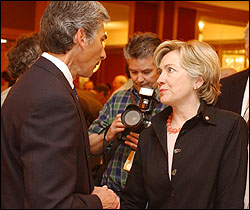Archives
Attendance at conference dispels any doubts about bioinformatics center
By ELLEN GOLDBAUM
Contributing Editor
If any doubts lingered among scientists, politicians or business executives about the future prospects for the University at Buffalo Center of Excellence in Bioinformatics, they were erased last Friday as nearly 200 scientists representing the U.S., Canada, India, the Netherlands, the United Kingdom, Italy and Japan gathered in the Adams Mark Hotel in Buffalo for the first annual "Frontiers in Bioinformatics" symposium.

Sen. Hillary Rodham Clinton chats with Erie County Executive Joel Giambra during UB Business Partners Day.
PHOTO: NANCY J. PARISI
Experts in bioinformatics from Harvard and Cornell universities attending the weekend-long symposium gave the center hearty endorsements, telling representatives of the news media that it is well positioned to play a leading role in the unfolding post-genomics revolution.
At lunchtime, the hotel's ballroom was filled to capacity with close to 400 business executives, community leaders and university representatives gathering for UB Business Partners Day, where Igniting Ideas Awards were presented to Sen. Hillary Rodham Clinton and Rep. Tom Reynolds for their contributions to the center.
The day's events amounted to a grand show of support for the center of excellence, which was founded in 2001 by Gov. George E. Pataki.
"Robert Frost, the poet, once said that an idea is a feat of association," Reynolds said as he accepted his award. "Can I tell you how proud I am to be associated with this truly outstanding idea? When we work together, there isn't anything we can't accomplish. Today, together, we can't help but succeed."
Clinton echoed those sentiments, noting that by focusing its energy and resources on a few key areas—in this case, bioinformatics and related technologies-Buffalo is following an economic—development strategy that has worked in other communities.
"This center of excellence is an absolute sure bet, so long as we stay committed and the community stands behind it," she said. "Even beyond the specifics of this project, what got me excited about it was the extraordinary support. There were so many loud voices in Buffalo saying 'We're going to bet on this.'"
Scientists heard a similar message during the conference's opening remarks from Jeffrey Skolnick, director of the center of excellence.
Pointing to a slide that listed the event's sponsors, which ranged from internationally known corporations like Dell to local companies like The Buffalo News and Robitaille Relocation and Real Estate, Skolnick noted that there was so much support for the center in Western New York that not only is the local business community often eager to step up to the plate before being approached, but in one case, an individual insisted on making a contribution to the conference.
"It is remarkably gratifying how much this community has contributed to this effort," he said. "The community is really very interested in seeing us succeed."
Community support, he said, enabled conference organizers to raise $44,000 to cover the speakers' expenses.
The conference was among the first in the world to explore collaborative approaches to structural genomics, evolutionary genomics and large-scale simulations of genome annotation, Skolnick said.
"We want to establish Buffalo as the place where we can bring together multiple disciplines," he said.
"You've heard of the Gordon research conferences and the Cold Spring Harbor meetings," he said. "Our version is the Buffalo symposium on bioinformatics."
Harold Scheraga, George W. and Grace L. Todd Professor of Chemistry Emeritus in the Baker Laboratory of Chemistry and Chemical Biology at Cornell, pointed out that Skolnick was "superbly qualified" to head the center.
He added that the addition of Norma Jean Nowak as the center's director of scientific planning also was critical because of her expertise as an experimentalist.
Nowak said that her role is primarily to integrate with the needs of the center the science that exists in Buffalo in fields ranging from microbial pathogenesis to immunology and vaccines and many others.
Skolnick noted that part of the effort to put the center on the map in the scientific world involved showing off Buffalo's scientific assets to conference attendees.
"One 4,000-processor supercomputer is worth a thousand words," he said.
At the same time, he told the scientists that the center is recruiting four senior faculty and four junior and mid-level faculty.
"During the conference, we may try to convince some of you to join us," he said with a smile.
In addition to the local support, corporate sponsors for the scientific conference included Dell, EMC2, Ernst & Young, InforMax and Blueprint. Sponsors of UB Business Partner Day included Eric Mower and Associates, Motorola and Praxair.
